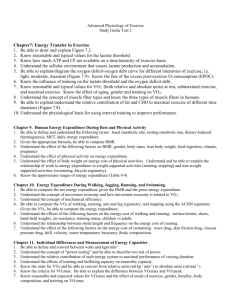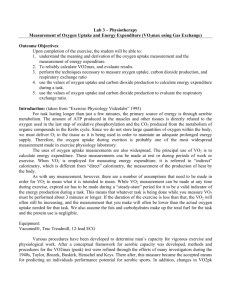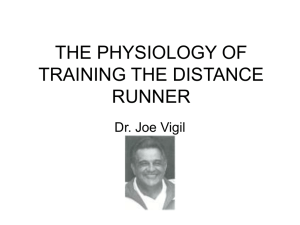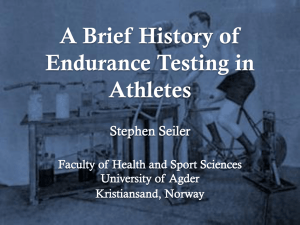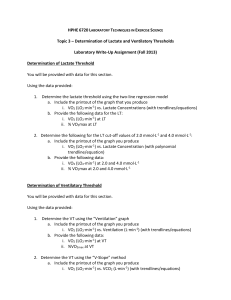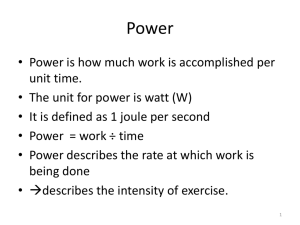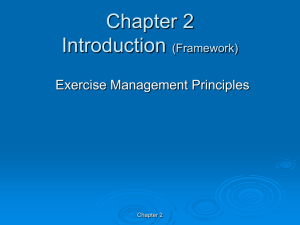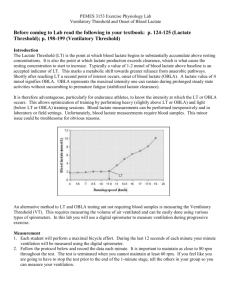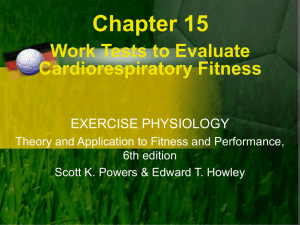Chapter 20 Laboratory Assessment of Human Performance
advertisement
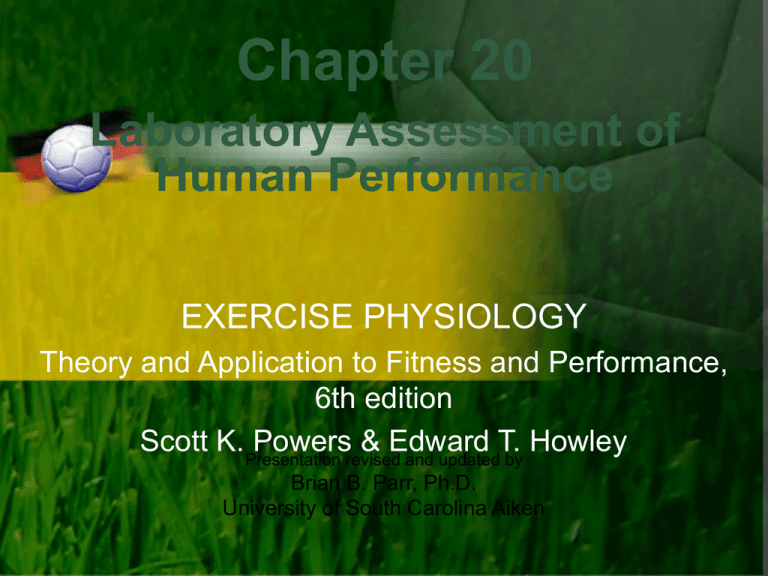
Chapter 20 Laboratory Assessment of Human Performance EXERCISE PHYSIOLOGY Theory and Application to Fitness and Performance, 6th edition Scott K.Presentation Powersrevised & Edward T. Howley and updated by Brian B. Parr, Ph.D. University of South Carolina Aiken Factors That Contribute to Physical Performance Figure 20.1 What the Athlete Gains From Physiological Testing • Benefits – Information regarding strengths and weaknesses • Can serve as baseline data to plan training programs – Feedback regarding effectiveness of training program – Understanding about the physiology of exercise • What physiological testing will not do: – Accurately predict performance from single battery of tests Effective Physiological Testing • Physiological variables tested should be relevant to the sport • Tests should be valid and reliable • Tests should be sport-specific • Tests should be repeated at regular intervals • Testing procedures should be carefully controlled • Test results should be interpreted to the coach and athlete Direct Testing of Maximal Aerobic Power • VO2max is considered the best test for predicting success in endurance events – Other factors are also important • Specificity of testing – Should be specific to athlete’s sport • Exercise test protocol – Should use large muscle groups – Optimal test length 10-12 minutes • Start with 3–5 minute warm-up • Increase work rate to near maximal load • Increase load stepwise every 1–4 minutes until subject cannot maintain desired work rate Direct Testing of Maximal Aerobic Power • Criteria for VO2max – Plateau in VO2 with increasing work rate • Rarely observed in incremental tests – Blood lactate concentration of >8 mmoles•L-1 – Respiratory exchange ratio 1.15 – HR in last stage 10 beats•min-1 of HRmax Determining VO2 Max Figure 20.2 Determination of Peak VO2 in Paraplegic Athletes • Paraplegic athletes can be tested using arm exercise – Arm ergometers – Wheelchair ergometers • Highest VO2 measured during arm exercise is not considered VO2max – Called “peak VO2” • Higher peak VO2 using accelerated protocol – Test starts at 50–60% of peak VO2 – Limits muscular fatigue early in test Laboratory Tests to Predict Endurance Performance • Lactate threshold – Exercise intensity at which blood lactic acid begins to systematically increase • Critical power – Speed at which running speed/time curve reaches plateau • Peak running velocity – Highest speed that can be maintained for >5 sec Use of the Lactate Threshold to Evaluate Performance • Lactate threshold estimates maximal steady-state running speed – Predictor of success in distance running events • Direct determination of lactate threshold (LT) – 2–5 minute warm-up – Stepwise increases in work rate every 1–3 min – Measure blood lactate at each work rate – LT is the breakpoint in the lactate/VO2 graph • Prediction of the LT by ventilatory alterations – Ventilatory threshold (Tvent) • Point at which there is a sudden increase in ventilation • Used as an estimate of LT Lactate Threshold Figure 20.3 Ventilatory Threshold Figure 20.4 Measurement of Critical Power • Critical power – Running speed at which running speed/time curve reaches a plateau – Power output that can be maintained indefinitely • However, most athletes fatigue in 30–60 min when exercising at critical power • Measurement of critical power – Subjects perform series of timed exercise trials to exhaustion • Prediction of performance in events lasting 3–100 min – Highly correlated with high VO2max and LT Concept of Critical Power Figure 20.6 Measurement of Peak Running Velocity • Predictor of performance in endurance events lasting <20 minutes – High correlation between peak running velocity and 5 km race time • Measurement of peak running velocity – Progressively increasing speed on treadmill – Highest speed that can be maintained for more than five seconds Relationship Between Running Velocity and 5 km Race Performance Figure 20.5 Tests to Determine Running Economy • Higher economy means that less energy is expended to maintain a given speed – Runner with higher running economy should defeat uneconomical runner in a race • Measurement of the oxygen cost of running at various speeds – Plot oxygen requirement as a function of running speed – Greater running economy reflected in lower oxygen cost The Oxygen Cost of Running Figure 20.7 Estimating Distance Running Success Using LT and Running Economy • Close relationship between LT and maximal pace in 10,000 m race – Race pace at 5 m•min-1 above LT • Predicting performance in a 10,000 m race – Measure VO2max • Plot VO2 vs. running speed – Determine lactate threshold • Plot blood lactate vs. VO2 – VO2 at LT = 40 ml•kg-1•min-1 • VO2 of 40 ml•kg-1•min-1 = running speed of 200 m•min-1 10,000m 205 m•min-1 = 48.78 min – Estimated 10,000 m running time Running Economy and LT Results From Incremental Exercise Test Figure 20.8 Determination of Maximal Anaerobic Power • Tests of ultra short-term anaerobic power – Tests ATP-PC system – Jumping power tests – Running power tests • American football – Series of 40-yard dashes with brief recovery between • Soccer – Intermittent shuttle tests – Cycling power tests • Quebec 10 second test Determination of Maximal Anaerobic Power • Tests of short-term anaerobic power – Tests anaerobic glycolysis – Cycling tests • Wingate test – Subject pedals as rapidly as possible for 30 seconds against predetermined load (based on body weight) – Peak power indicative of ATP-PC system – Percentage of peak power decline is an index of ATP-PC system and glycolysis – Running tests • Maximal runs of 200–800 m – Sport-specific tests Energy System Contribution During Maximal Exercise Figure 20.9 Series of 40-yard Dashes to Test Anaerobic Power Figure 20.10 Evaluation of Muscular Strength • Muscular strength – Maximal force that can be generated by a muscle or muscle group • Isometric measurement – Static force of muscle using tensiometer • Free weight testing – Weight (dumbbell or barbell) remains constant – 1 RM lift, handgrip dynamometer • Isokinetic measurement – Variable resistance at constant speed • Variable resistance devices – Variable resistance over range of motion Printout From Isokinetic Dynamometer During a Maximal-Effort Knee Extension Figure 20.14

